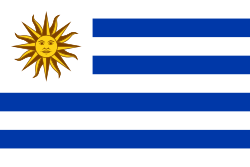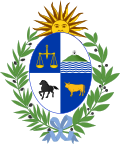
Back Uruguay ACE Uruguay Afrikaans Uruguay ALS ኡሩጓይ Amharic Uruguay AMI Uruguai AN Uruquaria ANG Yurugwai ANN उरुग्वे ANP الأوروغواي Arabic
Oriental Republic of Uruguay República Oriental del Uruguay (Spanish) | |
|---|---|
| Motto: Libertad o Muerte "Freedom or Death" | |
| Anthem: Himno Nacional de Uruguay "National Anthem of Uruguay" | |
| Sol de Mayo[1][2] (Sun of May)  | |
 Location of Uruguay (dark green) | |
| Capital and largest city | Montevideo 34°53′S 56°10′W / 34.883°S 56.167°W |
| Official languages | |
| Other languages | Portuguese |
| Ethnic groups (2023)[5] |
|
| Religion (2021)[6] |
|
| Demonym(s) | Uruguayan |
| Government | Unitary presidential republic |
| Yamandú Orsi | |
| Carolina Cosse | |
| Legislature | General Assembly |
| Senate | |
| Chamber of Representatives | |
| Independence | |
• Declared | August 25, 1825 |
| August 27, 1828 | |
| February 15, 1967 | |
| Area | |
• Total | 176,215 km2 (68,037 sq mi)[7] (89th) |
• Water (%) | 1.5 |
| Population | |
• 2023 census | 3,499,451[8] (132nd) |
• Density | 19.5/km2 (50.5/sq mi) (206th) |
| GDP (PPP) | 2024 estimate |
• Total | |
• Per capita | |
| GDP (nominal) | 2024 estimate |
• Total | |
• Per capita | |
| Gini (2022) | medium inequality |
| HDI (2023) | very high (48th) |
| Currency | Uruguayan peso (UYU) |
| Time zone | UTC−03:00 (UYT) |
| Date format | dd/mm/yyyy |
| Calling code | +598 |
| ISO 3166 code | UY |
| Internet TLD | .uy |
Uruguay,[c] officially the Oriental Republic of Uruguay,[d] is a country in South America. It shares borders with Argentina to its west and southwest and Brazil to its north and northeast, while bordering the Río de la Plata to the south and the Atlantic Ocean to the southeast. It is part of the Southern Cone region of South America. Uruguay covers an area of approximately 176,215 square kilometers (68,037 sq mi).[8] It has a population of almost 3.5 million people, of whom nearly 2 million live in the metropolitan area of its capital and largest city, Montevideo.
The area that became Uruguay was first inhabited by groups of hunter gatherers 13,000 years ago.[13] The first European explorer to reach the region was Juan Díaz de Solís in 1516, but the area was colonized later than its neighbors. At the time of European arrival, the Charrúa were the predominant tribe, alongside other groups such as the Guaraní and the Chaná. However, none of these groups were socially or politically organized, which contributed to their decline.[14] Amid territorial disputes, the Portuguese established Colônia do Sacramento in 1680, and the Spanish founded Montevideo as a military stronghold. Uruguay secured its independence between 1811 and 1828, following a four-way struggle involving Portugal, Spain, and later the United Provinces of the Río de la Plata and the Empire of Brazil. In 1830, the country enacted its constitution and was formally established as an independent state.[15]
During the early years following its independence, Uruguay remained subject to foreign influence and intervention, along with a series of internal conflicts and political turmoil.[16] From the second half of the 19th century, the country saw significant waves of European migration—mainly from Spain, Italy, and France—which greatly influenced its demographics and laid the foundation for modern-day Uruguayan culture and society.[17][18] In the early 20th century, a series of pioneering economic, labor, and social reforms were introduced, leading to the establishment of a highly developed welfare state. Coupled with its political stability, this contributed to the country being known as the "Switzerland of the Americas".[19]
Following Uruguay's independence, national politics were dominated by two political parties: the Colorado Party and the National Party, which clashed in several civil wars during the 19th century and are collectively known as the 'Traditional Parties'.[20] At various points in history, the Executive Branch was organized as a collegiate body, with the last instance of this occurring in 1967. A series of economic crises and the fight against far-left urban guerrilla warfare in the late 1960s and early 1970s culminated in the 1973 coup d'état, which established a civic-military dictatorship until 1985.[21] Uruguay is today a democratic constitutional republic, with a president who serves as both head of state and head of government.
In 2023, Uruguay was categorized as being a "full democracy" in The Economist Democracy Index,[22] and is highly ranked in international measurements of government transparency, economic freedom, social progress, income equality, per capita income, innovation, and infrastructure.[23][24] The country has fully legalized cannabis (the first country in the world to do so), as well as same-sex marriage and abortion. It is a founding member of the United Nations, OAS, and Mercosur.
- ^ Crow, John A. (1992). The Epic of Latin America (4th ed.). Berkeley: University of California Press. p. 457. ISBN 978-0-520-07723-2.
In the meantime, while the crowd assembled in the plaza continued to shout its demands at the cabildo, the sun suddenly broke through the overhanging clouds and clothed the scene in brilliant light. The people looked upward with one accord and took it as a favorable omen for their cause. This was the origin of the ″sun of May″ which has appeared in the center of the Argentine flag and on the Argentine coat of arms ever since.
- ^ Kopka, Deborah (2011). Central & South America. Dayton, OH: Lorenz Educational Press. p. 5. ISBN 978-1-4291-2251-1.
The sun's features are those of Inti, the Incan sun god. The sun commemorates the appearance of the Sun through cloudy skies on May 25, 1810, during the first mass demonstration in favor of independence.
- ^ IMPO (July 25, 2001). Personas con Discapacidad. Lengua de Señas Uruguaya [Disabled Persons. Uruguayan Sign Language – Law No. 17378] (Ley N° 17378) (in Spanish). El Senado y la Cámara Representantes de República Oriental del Uruguay reunidos en Asamblea General. Archived from the original on May 20, 2022. Retrieved May 30, 2022.
- ^ Meyers, Stephen; Lockwood, Elizabeth (December 6, 2014). "The Tale of Two Civil Societies: Comparing disability rights movements in Nicaragua and Uruguay". Disability Studies Quarterly. 34 (4). doi:10.18061/dsq.v34i4.3845. ISSN 2159-8371. Archived from the original on June 27, 2022. Retrieved May 30, 2022.
- ^ "Ascendencia étnico-racial principal, por categoría, según departamento - Censo 2023". 2024 (in Spanish). Instituto Nacional de Estadística. Retrieved January 21, 2025.
- ^ "Encuesta Continua de Hogares (ECH) – Instituto Nacional de Estadística". Archived from the original on December 8, 2022. Retrieved August 15, 2022.
- ^ "Uruguay". The World Factbook (2025 ed.). Central Intelligence Agency. Retrieved June 22, 2023. (Archived 2011 edition.)
- ^ a b "Censo Nacional 2023 contabilizó 3.499.451 habitantes en Uruguay". Uruguay Presidencia (in Spanish). Retrieved October 12, 2024.
- ^ a b c d "Report for Selected Countries and Subjects: April 2024". imf.org. International Monetary Fund.
- ^ "GINI index". World Bank. Archived from the original on November 10, 2016. Retrieved July 15, 2024.
- ^ "Human Development Report 2025" (PDF). United Nations Development Programme. May 6, 2025. Archived (PDF) from the original on May 6, 2025. Retrieved May 6, 2025.
- ^ Wells, John C. (1990). Longman pronunciation dictionary. Harlow, England: Longman. p. 755. ISBN 0-582-05383-8. entry "Uruguay"
- ^ "Hace 13.000 años cazadores-recolectores exploraron y colonizaron planicie del río Cuareim" [13,000 years ago, hunter-gatherers explored and colonized the Cuareim River plain]. archivo.presidencia.gub.uy (in Spanish). Archived from the original on March 18, 2014. Retrieved May 17, 2021.
- ^ "¿Por qué ya no hay indígenas en Uruguay?". El Observador (in Spanish). Retrieved January 11, 2025.
- ^ Jacob, Raúl; Weinstein, Martin (1992). "Modern Uruguay, 1875–1903: Militarism 1875–90". In Rex A. Hudson; Sandra W. Meditz (eds.). Uruguay: A Country Study (2nd ed.). Washington DC: Federal Research Division, Library of Congress Country Studies. pp. 17–19. ISBN 978-0-8444-0737-1. Archived from the original on April 30, 2011. Retrieved February 23, 2011.
- ^ Facal Santiago, Silvia (September 21, 2007). Recorriendo el largo camino de la integración: los judíos alemanes en Uruguay [Traversing the long road of integration: German Jews in Uruguay]. Amérique Latine Histoire et Mémoire. Les Cahiers ALHIM.
- ^ Pastor, José Manuel Azcona (2004). Possible Paradises: Basque Emigration to Latin America. Reno, Nevada: University of Nevada Press. p. 232. ISBN 9780874174441.
- ^ "Inmigrantes | 1811-2011". www.1811-2011.edu.uy (in Spanish). Archived from the original on July 18, 2024. Retrieved January 15, 2025.
- ^ "URUGUAY A HAVEN FOR REFUGEE SUMS; Gold Flows to 'Switzerland of Americas' Since Korean War – Foreign Trade Booms". The New York Times. January 3, 1951. p. 75. ISSN 0362-4331. Archived from the original on August 11, 2017. Retrieved May 5, 2024.
- ^ Barreiro, Julio (1993). "El sistema de partidos políticos en Uruguay" [The political party system in Uruguay] (PDF). Inter-American Court of Human Rights (in Spanish). Archived (PDF) from the original on February 7, 2025.
- ^ "Back to Democracy in Uruguay". Washington Post. December 27, 2023 [30 November 1984]. ISSN 0190-8286. Retrieved May 5, 2024.
- ^ "Democracy Index 2023". Economist Intelligence Unit. Retrieved February 2, 2025.
- ^ "Uruguay Rankings" (PDF). June 2013. Archived from the original (PDF) on February 1, 2017. Retrieved April 21, 2017 – via Embassy of the United States of America.
- ^ "Spartacus Gay Travel Index" (PDF). spartacus.gayguide.travel. February 29, 2024. No. 8, p. 2. Archived (PDF) from the original on September 14, 2017. Retrieved September 3, 2020.
Cite error: There are <ref group=lower-alpha> tags or {{efn}} templates on this page, but the references will not show without a {{reflist|group=lower-alpha}} template or {{notelist}} template (see the help page).
Cite error: There are <ref group=note> tags on this page, but the references will not show without a {{reflist|group=note}} template (see the help page).
© MMXXIII Rich X Search. We shall prevail. All rights reserved. Rich X Search

